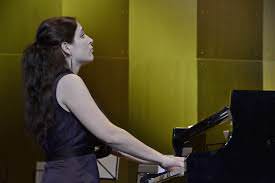World orchestras are at their most interesting when they bring a blend of their native musical language with the European tradition that defines “classical music.” With the help of two soloists, one three times the age of the other, the State Symphony Orchestra of Mexico delivered a varied program with varied results at the George Mason Center for the Arts last Saturday night.

The orchestra performs a lot of music written by Spanish composers, but its biggest revelation on Saturday was a piece by a native Mexican named Manuel Ponce called simply the Romantic Piano Concerto for piano and orchestra. This early 20th-century composer is championed by the State Symphony’s long-time music director, Enrique Bátiz, and also, interestingly, by a young Russian pianist, Irina Chistiakova, who came to Mexico a few years ago and won a competition with the piece.
Ms. Chistiakova, who now frequently travels with the State Symphony in between her continuing studies at the Moscow Conservatory, delivered a great interpretation of the Ponce concerto, which is kind of a cross between Hispanic flavors and the Brahms-Tchaikovsky school of late 19th century (or, in musical terms, “Romantic”) lush tonalities. Virtuoso passages alternated with attractive melodies, although the concerto features more of the pianist and orchestra acting in symbiosis rather than in contrast or “conversation” as many European concertos do.
Press reports indicate that Mr. Bátiz sometimes has trouble getting American venues to agree to put Ponce’s music on the State Symphony’s appearances because Ponce is so little known outside of Mexico. Kudos to George Mason for agreeing to this expansive program, not to mention the Center for the Arts’ terrific ongoing record in general for bringing international orchestras to Fairfax County.
Doing double duty on the program, the 24-year-old Ms. Chistiakova also performed a far more famous work, Nights in the Gardens of Spain by Manuel de Falla. This three-movement “tone painting” with extraordinarily evocative moods and colors calls for a large orchestra with piano solo sometimes performing typical “concerto” solo lines and at other times injecting atmosphere into the orchestra as another instrument.
Ms. Chistiakova’s clearly traditional Russian training is a little heavy on the pedal for this music, and I’ve love to see more internal articulation of the off-beat notes so that they “read” better among the massed forces. Her rather amazing life of being both an ongoing student in a European conservatory and a traveling artist with an orchestra in a different hemisphere speaks well for her ability to develop this diversity of approach in the future.
The apex of the evening’s native flavor came before intermission, when 72-year-old Mexican guitar legend Alfonso Moreno appeared to perform Joaquín Rodrigo’s Concierto de Aranjuez with the orchestra. Talk of knowing music in your bones – Mr. Bátiz knew the composer (who died in 1999) personally, and Mr. Moreno has performed this music for decades. (You’ll recognize the second movement from countless insertions in popular culture – check out the YouTube video below.)
The short and charming Mr. Moreno was the very picture of being “one” with his instrument – with his left foot up on a stool he practically wrapped himself around his guitar as he performed the piece. Although he played into a microphone, it was a very salon-oriented performance, and there were times either the guitar or the orchestra sounded a bit dry or remote. But the visual and aural experience of watching this legendary guitarist linger over passages that go to the core of his being was a special experience for the George Mason audience.

Probably the least successful part of the evening was the opening number, an orchestral arrangement of three Spanish dances for piano by Enrique Granados. There are certainly a hundred different ways to conduct an orchestra, but it was hard to understand Mr. Bátiz’s incredibly languid approach here, with very slow and unclear beats to the woodwind instruments that seemed to confuse them right from the top of the piece and led to ragged entrances.
Something must account for Mr. Bátiz’s energy level on the podium often seeming to have little correlation with the music of the moment. But the musicians nicely barreled through the concert and gave the George Mason audience a rich and varied palette of music to take home with them.
For those in the audience or elsewhere who want to follow this orchestra’s travels, it’s worth noting that while GMU billed it as the “State Symphony Orchestra of Mexico,” that’s not really the best translation of its name. More precise would be the State of Mexico Symphony Orchestra, meaning it was founded in 1971 to represent one of the country’s 31 states – the one that happens to be called, like the country, “Mexico.” Or just go by its name in Spanish, Orquesta Sinfónica del Estado de México. It’s certainly a treasured institution.
Running Time: 2 hours and 10 minutes, with one 15-minute intermission.
The State Symphony Orchestra of Mexico performed on Saturday, January 31, 2015 at 8 p.m. at George Mason University’s Center for the Arts – 4373 Mason Pond Drive, Fairfax, VA. For future events at The Center for the Arts, go to their calendar.
Rating:




